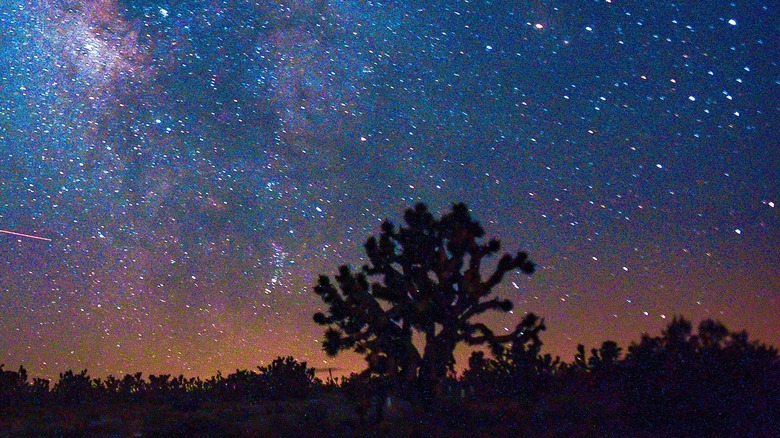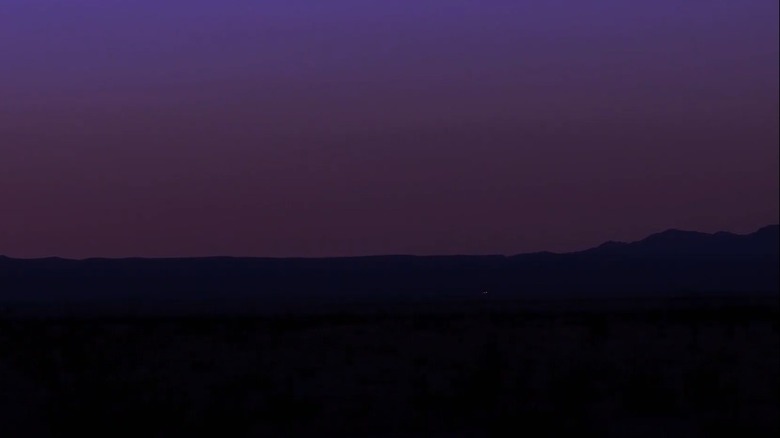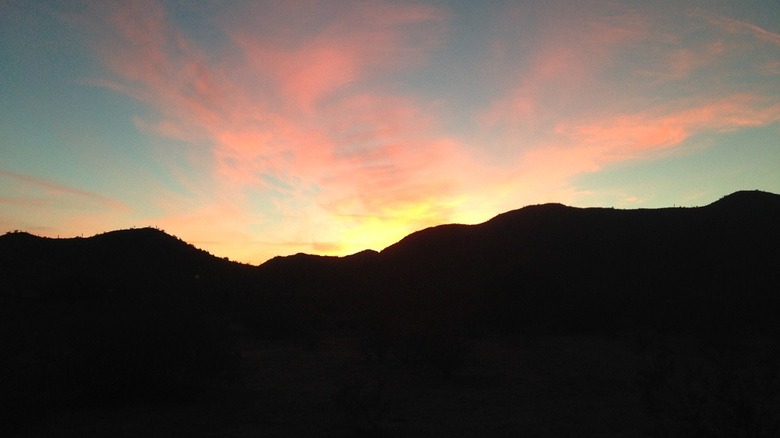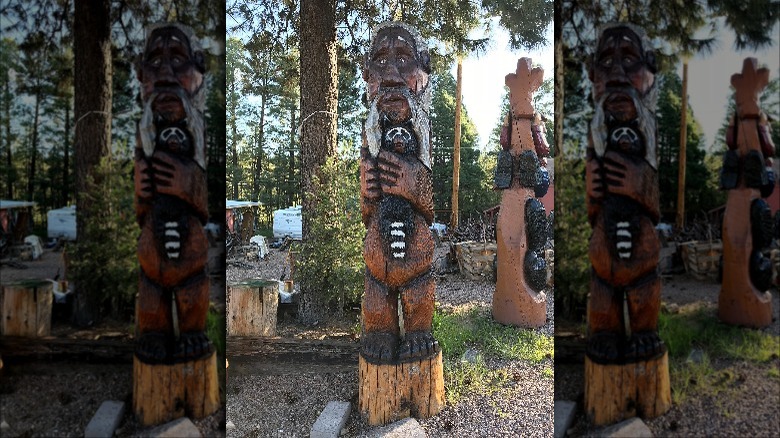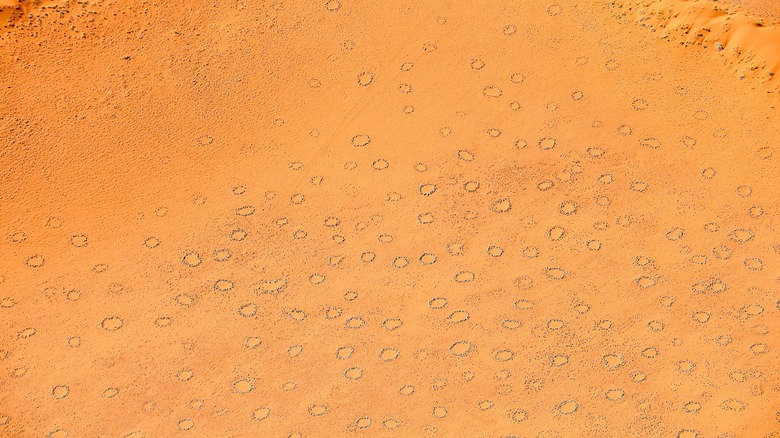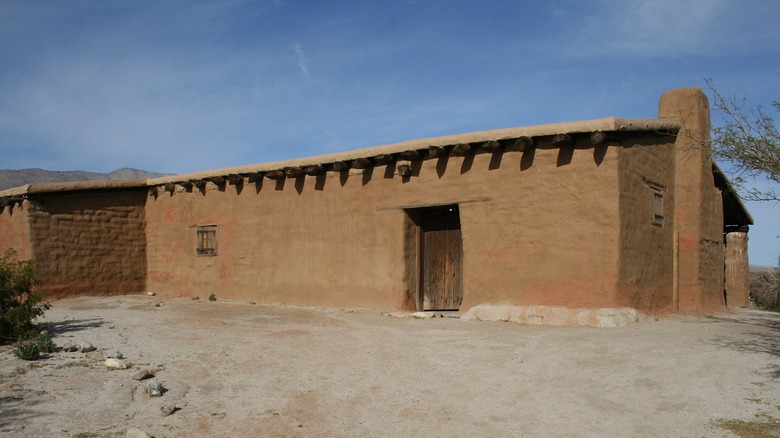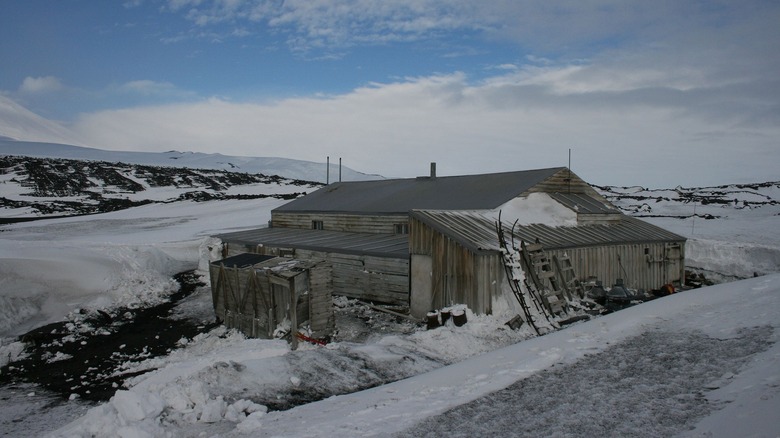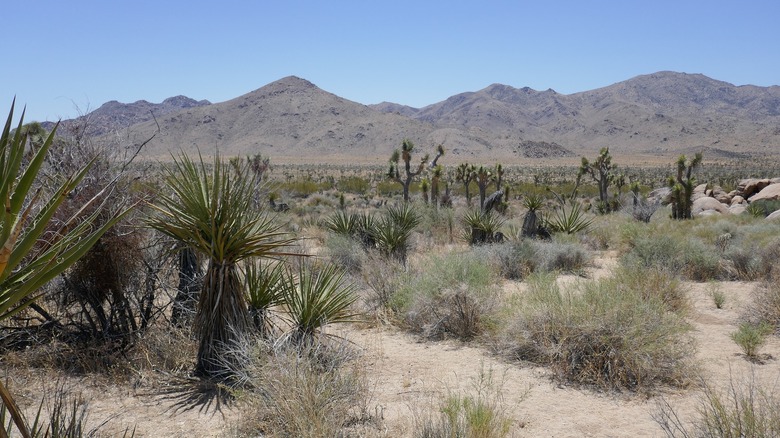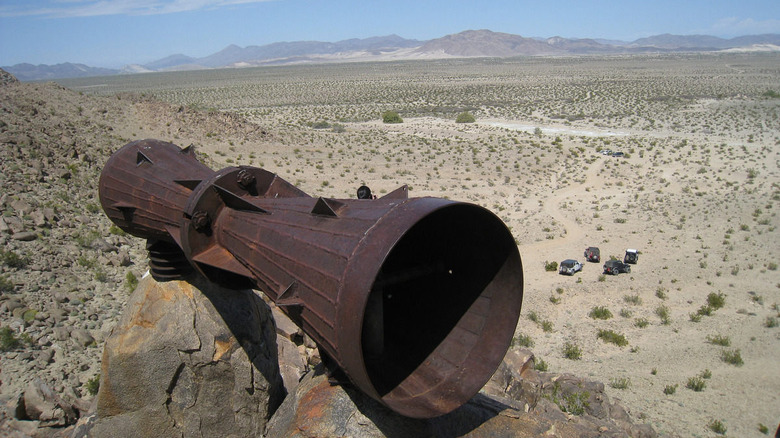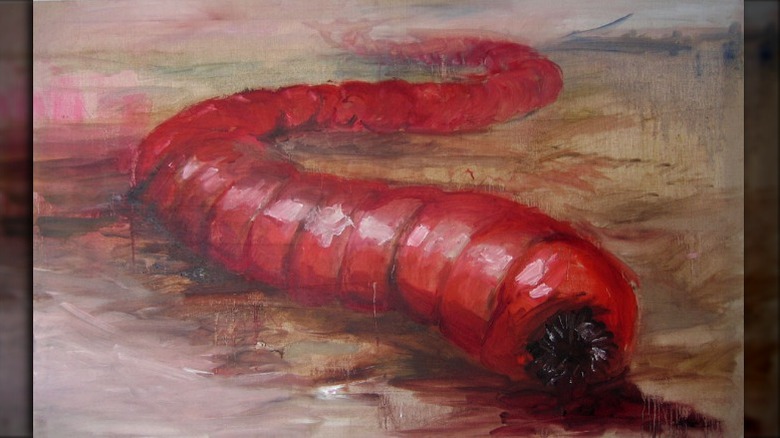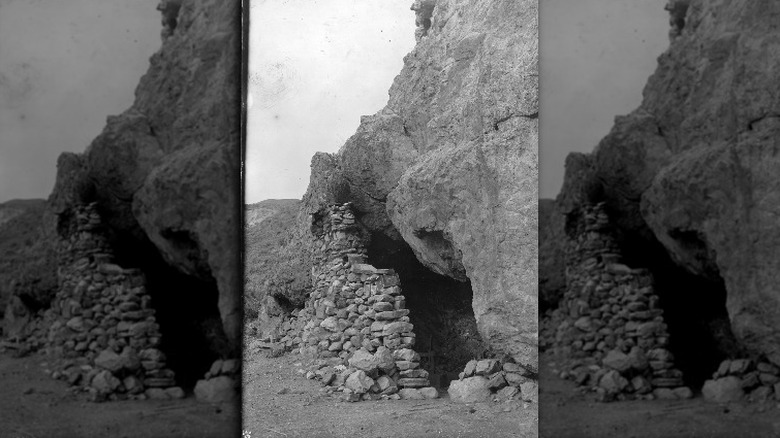Strange Stories About The Desert That Will Keep You Up At Night
It's easy to get creeped out in a desert. For many, they're already pretty eerie places, with wide, desolate vistas and intense environments that could quickly turn an unwary traveler into a pile of bones in some forgotten corner of the land. The harsh end that awaits someone who went off the trail without the necessary knowledge or water is enough to make anyone stay inside. Even those who see the beauty of the desert and its unique environment may still feel a bit of a chill at certain times, however.
Sure, maybe that's just because the sun dipped below the horizon and a surprising cold is beginning to take over the dry air. Or is it because you're certain that you just saw something watching you from the nearby ridge? And did you hear an odd rustle emanating from that stand of piñon pine? Are you absolutely sure that you're alone out here?
As it turns out, deserts across the globe are packed full of strange tales, from odd lights flickering in the skies above Texas to a deadly cryptid that might just be stalking the sands of Mongolia's Gobi Desert. Even if you consider yourself a true-blue skeptic, you may still find yourself getting a little jumpy considering what might be waiting for you out there in the desert. If nothing else, you may want to avoid reading these stories right before bedtime, lest the strange tales of the desert keep you up at night.
No one knows what the Marfa Lights might be
If you head out in the desert just outside the West Texas town of Marfa, you can expect to encounter a strange and oddly consistent phenomenon known as the Marfa Lights. According to Texas Monthly, your best bet is to head about nine miles east of the city and plant yourself alongside a small stretch of road — U.S. Route 67, to be specific — that's since become notorious for watching the lights. In fact, it's so well-known now that there's a series of helpful and official road signs designating the viewing area.
If you're patient and conditions are right, you could very well see the lights, which often appear as glowing yellow and white orbs that move about, fade in and out, and reappear, all far off in the distance. Few people are really afraid of them, but good explanations for these strange lights are pretty scanty.
The Texas State Historical Association reports that sightings of the Marfa Lights date back to 1883, when a ranch worker entered the first documented sighting of the lights. Since then, they've been spotted by many. According to LiveScience, current scientific theories for the lights encompass mirages, flaming gases, electric charges created by some as-yet-unknown geological, and more — yet no one's been able to prove much about these eerie lights just yet. You might still be convinced that the lights are something creepier, from extraterrestrial visitors to the ghosts of battling conquistadors.
A black mist trails people near Casa Grande Mountain
Casa Grande Mountain may seem innocuous enough if you happen to be driving by or even hiking while the sun's out, with a perfectly nice set of trails and open spaces for responsibly enjoying nature (via City of Casa Grande). But why don't you wait until dark? At that point, you'll surely discover that the Arizona desert around the landmark between Phoenix and Tucson can get pretty unsettling, as the light fades and the sounds of the desert seem to amplify around you. And that's all before the black mist settles in.
According to Weird U.S., Casa Grande Mountain is haunted by a strange and unexplained mist that follows people visiting as the daylight wanes. People who say they've encountered it report that it seems like a very vague but definitely dark mist that, if you let it surround you, will give you a distinct and very uncomfortable sense of unease.
If you ask some, the mist is somehow connected to the ancient indigenous people who lived in the area, including the Hohokam people who once flourished in the region and whose descendants make up members of local modern tribes like the Pima and Tohono O'odham (via National Park Service). Of course, it could also be gunpowder-infused smoke from a nearby shooting, atmospheric phenomena, or the result of one too many creepy tales pushing visitors to see something that may not physically be there.
The Mogollon monster stalks the high deserts of Arizona
If the creepy black mist doesn't bother you too much, don't rest on your laurels just yet. The desert of Arizona apparently contains quite a few strange tales that are bound to unsettle you sooner or later. And if a spooky nighttime cloud isn't going to do it for you, then how about a hulking monster lumbering amongst the cacti?
That would be the Mogollon Monster, a Sasquatch-like creature that Weird Arizona claims is spotted most often around the rim of the Grand Canyon, though it reportedly ranges quite a bit farther south, too. Descriptions of the creature tend to fit with other Bigfoot encounters, including a bipedal ape of great height with plenty of fur, a long stride, and a substantial shoe size. The Mogollon Monster is also said to stink to high heaven, with a distinct odor that's been compared to rotting fish, skunk spray, or decaying plant matter. No matter the exact smell, no one's reported enjoying the monster's odor.
But perhaps the most telling mark of the Mogollon Monster is the eerie silence that's said to precede its entrance. According to Williams-Grand Canyon News, the first report of an encounter with the smelly, menacing creature came out in 1903, when a grey-haired individual rushed a hunter while it was wielding a club. And another supposed sighting came in 2014, when a hiker spotted a "troll-like creature" with bumpy skin that ran away from her on two legs.
What are the 'fairy circles' of the Namib Desert?
They may sound almost magical, but don't let the enchanting name fool you. For many folks, the so-called "fairy circles" that are sometimes found in southern Africa's Namib Desert are unexplained and therefore plenty creepy. After all, how could nature produce such perfect circles of vegetation in regular formations, and in such a harsh environment?
Though there's no doubt that the Namib Desert is a truly arid place, the BBC reports that it does feature the occasional patch of trees, shrubbery, or grass. Sometimes, that grass arises in ring-shaped formations, which look odd indeed in the middle of the desert. Himba tribespeople sometimes claim that these rings of vegetation are the footprints of deities, while others claim that subterranean dragons give off fiery exhalations that bubble up and then burn the plants above.
Even if a Himba person doesn't really believe the stories, they're still at a loss to explain the fairy circles, as is pretty much everyone else who studies them. And there are quite a few, too, with the circles sometimes arising in fields of eerie, silent rounds. The consistently barren centers of the circles, as well as the regular spacing between them, as if they were placed there rather than sprouting up naturally, makes it all the more confusing and strange.
One California desert spot is reportedly full of ghosts
At one point in time, the sight of Vallecito Stage Station was a welcome one for travelers who had made it through California's killer desert. And, according to Legends of America, quite a few people had to make that treacherous journey in the 19th century, when the Gold Rush called many hopefuls to southern California and beyond. The fact that it was a regular stop on the mail route helped keep the station busy, too. Yet, if you visit today, you'll see that the place is pretty thoroughly uninhabited, though it's still standing in a park and campground managed by San Diego County.
Uninhabited, that is, except for the ghosts. If you believe the stories shared at Legends of America, the desert spirits still hanging around Vallecito Stage Station are part of a pretty varied cast of characters that seemingly can't move on from this now lonely little stagecoach station in the middle of the Californian desert. The specters include various prospectors and bandits, as well as a phantom horse and ghostly stagecoach (both also produced by bandit activity, naturally). The most well-known ghost there is surely the "White Lady," a woman who died of illness at the station sometime in the 1850s. She was buried nearby in her white wedding dress and is now said to move about the grounds in her last set of clothes, still waiting for the stagecoach to take her out of there.
Ghosts may haunt the Antarctic desert
Yes, most of Antarctica is desert. Though you may be thinking of the southernmost continent as a snowbound environment, it's actually seriously lacking in precipitation, to the point where it's one of the driest places on the entire planet, according to the Chicago Tribune. This desert holds plenty of secrets and eerie stories that are sure to make the hairs on the back of your neck stand up, even when you're wearing your warmest parka. These include not one, but two historic huts that some claim are still inhabited by the presences of early polar explorers.
First, there's the well-preserved Scott's Hut at Cape Evans, reportedly haunted by the ghosts of Sir Robert Scott and the other polar expedition members that spent the winter of 1911 there (via Polar Latitudes). There are the standard ghostly voices and vague, half-seen figures, but visitors have also reported a feeling of dread, perhaps inspired by the original expedition's own growing sense of doom as their journey became increasingly dangerous.
You might also visit Ernest Shackleton's hut on Ross Island, where some of the same phenomena are said to occur. Sir Edmund Hillary, who completed the first summit of Mount Everest with Tenzing Norgay, claimed to have encountered a vision of Shackleton there. And, according to "Ghosts – or the (Nearly) Invisible," Shackleton himself sensed a mysterious and unseen extra member of the party that undertook a desperate march to get his expedition out of the Antarctic wasteland.
Palm Springs is reportedly a UFO hotspot in the desert
Though it's a well populated resort city in California, make no mistake about Palm Springs: it's still very much in the desert. And, like so many deserts, the expanse in and around Palm Springs has some seriously creepy and strange stories to its credit. For many in the area, those stories all start with a look up towards the skies.
That's because, as Desert Sun reports, the city and its environs is a UFO hotspot. Stories include strange lights seen wheeling about the sky, as well as a sighting from 1952 of a strange and spectacular-sounding diamond that darted around above viewers for an extended period of time. Two years later, a pair of pilots in two completely separate planes reported seeing what could have been the same blue light zipping around at a lofty 13,000 feet above Palm Springs. And, maybe unsurprisingly, there is a whole spate of blurry photos and even some film footage that purportedly shows odd craft buzzing Palm Springs.
Various people, including military personnel, have dismissed much of these as hoaxes or cases of mistaken identity. And it could well be that the odd lights are very often misattributed atmospheric phenomena or human-piloted aircraft. But the sheer number of sightings, combined with the eerie atmosphere of the desert itself and the skies above it, are still enough to keep many wondering just what's visiting the airspace above Palm Springs.
Why is there a megaphone in the Mojave Desert?
Depending on the exact desert you're in, it could appear as a veritable ocean of sand or perhaps a rocky landscape of boulders and mesas stretching off into the distance. But, get a little closer, and you'll likely find unique features that break up the landscape. That could be an oasis, a town, an animal's den, or even a whimsical and gently mysterious phone booth in the arid backcountry of California (via Atlas Obscura).
But there's something really, truly creepy about the giant megaphone in the Mojave Desert. According to How Stuff Works, the installation is in an especially rural corner of the Mojave Desert National Preserve in southern California. It consists of two heavy pieces of metal that have been assembled into one eight-foot spectacle that sits on a pair of boulders. Given the weight and size, it probably took multiple people to haul the megaphone to its spot.
Beyond the bare physical description, though, we know next to nothing about the megaphone. Who put it there? Why drag it out to such a desolate part of the desert, so far from any known towns or military installations? Few even know how long it's been standing watch over the desert, though some estimate it's been there 30 years or longer. The best guesses are that it's some sort of measuring equipment for Edwards Air Force Base, but that still remains a guess for this creepy creation in the Mojave.
The Mongolian death worm supposedly lives in the Gobi Desert
If the American desert sounds like it's too full of creeps, you may be tempted to leave it all behind and visit another desert entirely. But, depending on whether or not you believe the stories, you'll still need to keep a careful eye out for all sorts of hazards. There are the standard issues of staying cool, avoiding the sun, and drinking enough water, sure. Plus, if you've run all the way to Mongolia's Gobi Desert, you may also need to avoid a killer electrical worm.
The so-called "Mongolian death worm" is said to be a pretty large worm-like creature, measuring a skin-crawling three feet long, according to LiveScience. Various accounts and legends also maintain that it's typically red and has protrusions at both ends. It supposedly prefers to lie in the desert sands, waiting for unwary creatures to wander near. The worm then dispatches its victim with either a jet of venom or, as you may guess, a considerable electrical shock.
Skeptics will, naturally enough, point out the fact that no one's returned from the Gobi with evidence of a huge, killer sand worm. And it is indeed possible that some people have seen a snake (some species of which can spit venom) or lizard and mistaken it for the mysterious worm. But the tales of the creature remain, including amongst local Mongolian people, who call it the algoi-khorkhoi, which translates to the decidedly un-cuddly "large intestine worm."
Some people claim to have found catacombs beneath Death Valley
Sitting in the northern portion of Mojave Desert, Death Valley seems especially plagued by strange and creepy tales. Per The New York Times, there are eerie abandoned towns, rocks that seem to slide under their own power on the "Racetrack Playa," and plenty of ghost stories. That's not to mention the unsettling history of the Manson family, who attempted to hide out at nearby and unoccupied Barker Ranch after their bloody and deadly attempt to start a race war, according to the National Parks Conservation Association.
But Charles Manson was packed away into prison for the rest of his life, and it's difficult for many to be well and truly creeped out by some slippery rocks or abandoned buildings slowly fading into the desert. Don't think Death Valley is done with you yet, though. If you really want to be creeped out, consider looking into the legend of the Death Valley underground city.
According to Legends of America, it all reportedly started in 1931, when a prospector stumbled onto a cave system in the valley. The tunnels proved to be pretty extensive and also contained the remains of a mummified giant. The story was met with skepticism, especially because the tale-teller couldn't find the caves again. Then again, other claims and a Paiute legend also talk of subterranean and hidden cities, as well as huge ancient mummies. Perhaps someone is still living (or half-living) in the world beneath Death Valley.
